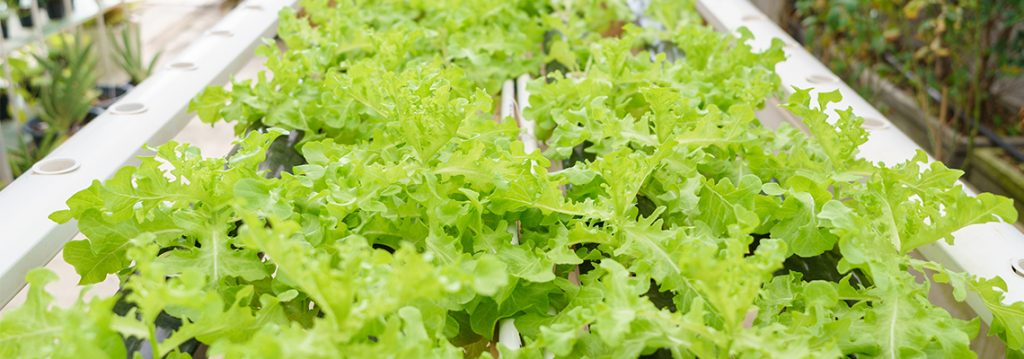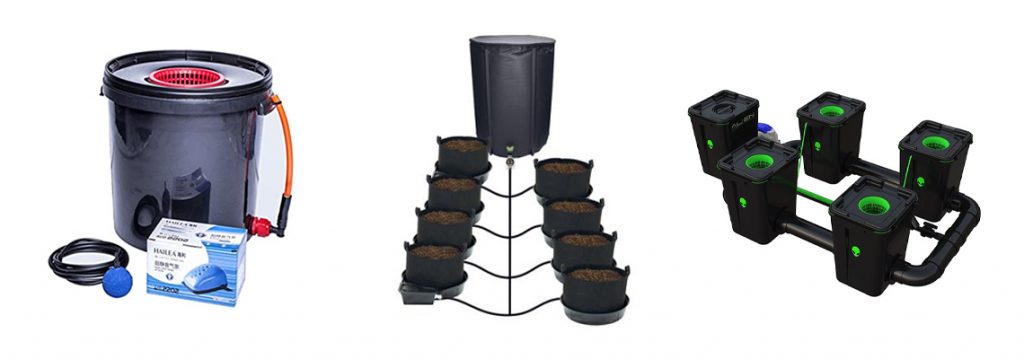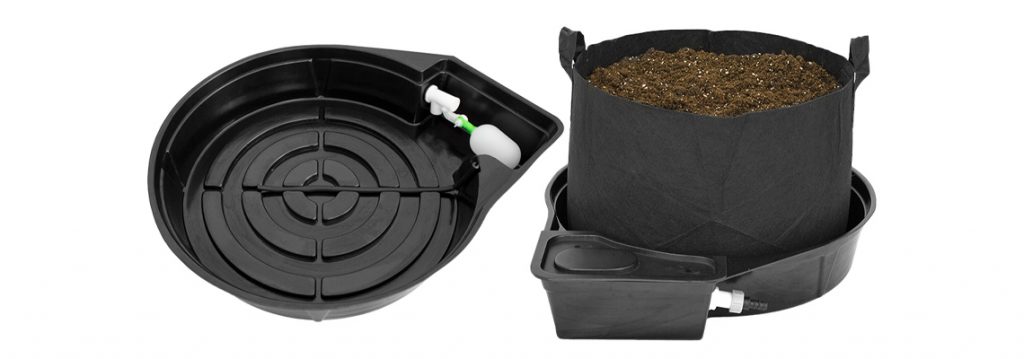
What Is The Best Hydroponics System on The Market?
So you’re interested in growing hydroponically? The idea of being able to grow your own crops all year round does sound like a tantalizing proposition. But, where to start? In this article, we take you through everything you need to know about hydroponics and hydroponic systems. As well as finding out what is the best hydroponics system on the market.
We’ll explain what hydroponics is, how it works, and what you could be growing in your hydroponic garden today. Alongside the different types of hydroponic systems that are available.
What Is The Best Hydroponics System on The Market: Index
- What is Hydroponics?
- How Does Hydroponics Work?
- What Can You Grow?
- The Types of Hydroponic Systems
- Best Hydroponic Systems on the Market
- How to Start Growing with a Hydroponic System
- 10 Quick Tips to Help
- How to Set Up Your MEGAPot System
- Where to Purchase The MEGAPot System?
- To Conclude: What Is The Best Hydroponics System on The Market?
What is Hydroponics?
Hydroponics was a term and process that was coined in the late 30s. To put it simply hydroponics is the process of growing plants without soil. Instead, the plant uses an inert substance (this is a substance that offers no additional nutritional information) to support the root system. Whilst the plant is given all of its nutritional needs through a solution fed to the plant directly to the roots via water.
Plants are known to grow faster, produce higher yields and more desirable crops versus growing in more traditional media form.
How Does Hydroponics Work?
In essence, you’re creating an environment for your plants and vegetables to live in with a hydroponics system. This allows you ultimate control over the temperature, the pH Balance of the water the plant is fed, the air-flow, and the amount of light the plants receive.
By controlling all of these factors, many risks related to growing plants are greatly reduced. The root system of your plant isn’t wasting energy fighting it’s way through heavy soil before it can grow. Instead, the plant can use that energy more wisely on growing, quicker, and larger than you previously thought possible.
What Items Do you Need to Grow?
To create your hydroponic garden, there are a few essentials that you will require.
Tent
Getting the correct tent for your setup is vital. Grow tents come in many shapes and sizes. So the likelihood is you’ll find a tent that’s right for the space you’re trying to fill rather quickly.
The most notable brands of grow tent are can be found at:
- Apollo Horticulture
- Vivosun
- Gorilla Grow
- Secret Jardin
Fan
Getting the airflow correct in your grow room is imperative, without enough oxygen likelihood is your plants will die. The size of fans and how many will vary depending on your setup.
Grow Lights
There are several brands of grow light on the market today. In fact, the marketplace is quite flooded with a whole wide range of lights to fit all sizes of grow room. A general rule of thumb is that for every square foot of space you want to light, you need roughly 32-50 watts of light.
Thermometer
One of the benefits of growing indoors is that you can control the temperature. However, you can’t control the temperature if you don’t know what it is. A cheap, but an extremely handy device for your indoor garden.
If it gets too hot or too cold it could mean wasted time and even worse wasted crops. Having a thermometer in your grow room is essential!
pH Balance and Meter
If you’re growing hydroponically then you’ll need to make sure that your water has the correct pH Balance. You can test it with a pH Meter. Most plants grow around a pH of 6-7 depending on the specific plant. If the pH isn’t what you expect you can adjust it by using pH balancing solutions.
At MEAGPot we sell specialist pH solutions that can help increase or decrease the pH of your plants. They are linked below.
Nutrients
Now your plant isn’t getting its nutrition from the soil. You have to give it the nutrition it needs by feeding its nutritional solutions through its water. Depending on if you’re growing in water or in a soil substitute you’ll need a different type of solution.
Below we have highlighted a few products from our BAC range that we think will help you on the road to green-fingered nirvana.
These products are perfect for those growing in a soil substitute.
These products are perfect for those growing fully with water.
Diary
It may sound like a bit of a basic idea and one that’s ‘a bit of a drag’ but keeping a diary is a great way for the grower to keep on top of feeding schedules, how far along each plant is in its life cycle, and a great way to keep an eye on any potential problems.
Timer
The last item that is essential to a hydroponic gardener and they can’t live without is a timer. Especially one that will switch your lights on and off. This is a great help especially if you can’t guarantee you’ll be there when you need to be.
What Can You Grow?
Next, we are going to take a quick look at some of the things you could be growing in your hydroponic system. There are many different things that you can grow.
If you are unsure about something you want to grow in the MEGAPot system, feel free to get in touch with us, and we can advise you.

Plants
All flowers and herbs including basil, chives, and mint can be grown in your chosen hydroponic system.
Fruits
You can grow strawberries, blueberries, and mostly any berry that would grow outdoor in the UK indoors or outdoors in a hydroponic system.
Vegetables
You can grow peppers, lettuce, tomatoes, radishes, cucumbers, beans, and much more in your hydroponic system.
The Types of Hydroponic Systems
Below we are going to go over the different types of hydroponics systems that are available for growers to take advantage of. We’ll then explore the pros and cons of each method. Helping you make an informed decision when choosing which hydroponic system is right for you.
MEGAPot Gravity Fed System
First on our lists, is our own personal pick: The MEGAPot. This product is a must for all growers using grow bags and inert mediums to grow their plants. And is the perfect choice for a beginner or more experienced growers. When you’re looking at the types of hydroponics available on the market the MEGAPot is an excellent choice for any beginners with a green-fingered itch.
Feeding has never been so easy because our gravity-fed system will do all the work for you! The MEGAPot Gravity system will catch any excess water and nutrients that have been left to pass through. From this point, you can then drain the system off with the handy drainage tap on the side.
To be used with grow bags it Mega versatile allowing growers to take advantage of the greatest source of power known to man, gravity to feed the plants. And the circular modular design allows the grower to rotate the plant to its needs. Allowing the plants to grow to its full potential.

Pros
- No electricity needed – while other parts of your growth may well need electricity to operate properly this won’t. Leaving you with some extra cash in your wallet to spend on other things.
- Circular design – the circular design of the MEGAPot means that you can rotate your plants as needed allowing all parts of the plant to receive the same amount of light.
- Scalable design – our scalable design means we’ve got you covered no matter the size of your growth from a single pot to 100 with MEGAPot anything is possible.
- Tapered sidewalls – the tapered sidewalls on the MEGAPot module allows for complete root pruning.
Cons
- Only suitable for grow bags – although the MEGAPot system is amazing it’s only good for those growers who are growing in a grow bag.
For more information on the MEGAPot System please visit here.
Wick Systems
Used for thousands of years now, wick systems are considered one of the more simple systems you can build. Using what is known as passive hydroponics, meaning you don’t need any air or water pumps to run the system. Wick systems are popular amongst those who like to grow smaller plants that don’t need a lot of nutrients to survive.
Instead, the nutrients are moved through the plant’s root system via a wick, which in theory could be something as simple as a rope or piece of felt. This is a good option for those looking to grow plants on the smaller side of the spectrum. Larger plants may struggle using this type of hydroponic system.
Nutrients are fed into water that is moved through the plant’s root system via a wick, this can be something as simple as rope or felt. Popular choices for growing media include coconut coir, perlite, or vermiculite.
Pros
- Automatic – if set up correctly Wick systems can be truly automatic and will do most of the work on its own.
- Great for beginners – no matter the age, the simplicity makes this a definite option for those who are starting their voyage in the seas of gardening.
Cons
- Not great for bigger plants – although fantastic for smaller plants this method of growing hydroponically won’t work out great for larger plants that need more nutrients to survive.
- Incorrect wick placement – not setting your wick correctly, will mean that your plants become starved of oxygen and die. This can be easily done and is a major downfall of this method of growing.
Deep Water Culture (DWC)
Commonly referred to as Deep Water Culture (DWC), this method has the plant’s roots suspended in the nutrient solution. Then air is provided to the plant directly to the roots with an air stone or diffuser. Much like other methods of growing hydroponically, the plant’s root system is supported by an inert growing medium.
Often considered the easiest to set-up. DWC hydroponics requires minimal materials to get started.
Pros
- Inexpensive and simple – DWC is notable for being reasonably cheap and easy to set up.
- Low maintenance – as well as being easy to set-up, water culture is also reasonably easy to maintain.
- Recirculating water– because this is a recirculating water method you will waste fewer nutrients.
Cons
- Not for the long term – this method isn’t great for plants with a longer growing cycle.
- Not for large plants – this is another method that works great with smaller plants. However, it doesn’t work as well with larger plants.
Ebb and Flow System (Flood and Drain)
Ebb and Flow or more appropriately sometimes called the flood and drain method. This style of growing is extremely popular with at-home indoor gardeners. This method sees the plants being placed in grow beds that are filled with an inert growing medium.
The grow bed hangs above a reservoir of nutrient-rich water that is then fed to the grow bed, flooding it until it reaches a certain point and begins to drain back into the reservoir.
Pros
- Recirculating water – like the water culture method, ebb and flow uses the recirculation of water which means less wastage.
Cons
- Roots dry quickly – if the environmental conditions of your room stops working or the pump fails the roots of your plant can dry out quickly.
- Medium heavy – this method is also known for using comparatively more growing medium than others we have discussed.
Drip System
Notable for being popular with more commercial growers, because of their ease of use on a large scale. But, a definite consideration for those looking to get started in the world of hydroponics. Like the other methods, the plants sit above a reservoir of nutrient-rich water. However, instead of the medium being flooded it is dripped into the medium at an adjustable rate.
Drip systems can be circulating and non-circulating. It all depends on the grower’s specific needs and what they wish to achieve with their system.
Pros
- Full Control – the drip system allows the grower an extremely high level of control when it comes to the plant’s feeding schedule.
- Sturdy – drip systems on a whole are quite sturdy. And because they administer less water on a whole there’s less chance something bad could happen quickly.
- Cheap start up costs – compared with other hydroponic systems we have discussed, drip systems are reasonably cheap to get started.
Cons
- Not for small gardens – although, quite cheap to set-up this method of hydroponic growing may not be the best for smaller gardens. As mentioned above, it is best suited for commercial growers. Or growers that plan to grow on a large scale.
- pH problems – when looking at the different types of hydroponics, it’s good to take into account all factors, and ease of use is definitely one of those. If you’re using a recirculating water design fluctuating pH may become an issue. Too much or too little pH in your plant’s water supply will mean poorly plants. And maybe even a wasted harvest for the grower.
- Lots of waste – another common problem with drip systems is that there can be an awful lot of waste involved in the process.
Nutrient Film Technology System (NFT)
This is another popular choice with commercial growers. Commonly Referred to as NFT, this method has lots in common with the deep water culture method. Plants sit in a channel above a reservoir of nutrient-rich water that is being constantly pumped through the plant’s root system.
Once the water has reached the bottom of the channel, it filters back into the main reservoir below. This makes a recirculating system, similar to deep water culture.
Unlike deep water culture, NFT doesn’t submerge the plant’s root system completely into the water. This forces the plant to reach for the water more giving the grower stronger, longer roots that will produce large healthy plants when fully grown.
Pros
- A small amount of medium – this technique doesn’t use much-growing medium to support the plant as some of the others we’ve talked about today.
- Recirculating water – again as with other hydroponic systems in this article, this method uses recirculating water, so this means less waste for the grower.
Cons
- Broken pumps – broken pumps can mean ruined crops and wasted harvests.
- Clogged roots – sometimes this method can lead to the roots being overgrown which can clog your channels. And in turn, prevent your plant from reaching its full potential.
Aeroponic Systems
The last method of growing we’re going to feature today is Aeroponics. This is similar to NFT in that the roots are mostly suspended in the air. However, instead of pumping the water through the roots, it mists the air with nutrient solution.
This method of growing has shown to be quite fast and a favorite with those on a schedule.
Pros
- More oxygen – because the roots have more oxygen available to them than in other methods, roots can breathe easier. Which then helps them grow to reach their full potential.
Cons
- Nozzle failure – as with other methods that are reliant on pumps and timers to feed plants, they can fail. Which could mean your roots could dry out if not correctly attended to.
- More expensive – aeroponic systems are more expensive than most other hydroponic systems. Which won’t make them top of the list for any wallet-conscious growers out there.
Best Hydroponic Systems on the Market
Hydroponics is fast becoming well known for being to grow your plants quicker when compared to other traditional methods of growing.
There are several different options to choose from. You just have to decide which hydroponic system is best for you.
We have compiled the top 8 hydroponic systems in the market. Giving each one a star rating out of 5.
| System Name | Type of System | Review | More Info |
| MEGAPot | Gravity Fed | ⭐⭐⭐⭐⭐ | Click here |
| Atami Wilma | Dripper | ⭐⭐⭐ | Click here |
| Oxy Pot Bubbler | DWC | ⭐⭐⭐⭐ | Click here |
| Farm Controller | Ebb and Flow | ⭐⭐⭐ | Click here |
| Alien RDWC Pro | DWC | ⭐⭐⭐⭐ | Click here |
| IWS Flood and Drain | Ebb and Flow | ⭐⭐⭐⭐ | Click here |
| EasyFeed | Gravity Fed | ⭐⭐⭐⭐ | Click here |

MegaPot
The Gravity fed system of the MEGAPot means that you don’t need electricity to operate it. Its circular design allows plants to be adjusted to receive the most amount of light possible and the modular design of the MEGAPot means it’s scalable from 1 to over 100 plants.
Its massive intake valve protects from blockages. An ideal choice for those who still wish to use grow bags in their set up but want the large crops and killer yields hydroponic growing can provide.
An excellent option for beginner and experienced growers alike. MEGAPot received 5 stars in our review table above.
Visit the MEGAPot website for more information.
Atami Wilma
A highly reviewed product on amazon this dripper system is a fantastic choice for those who want to grow smaller plants.
The dripper can be adjusted so feeding is on the schedule you want. On the downside, the drippers can be easily clogged. Which can mean problems down the line for your plants.
Check Amazon availability on this product here.
Oxy Pot Bubbler (Basement Lighting)
There are lots of different brands of deep water cultures or the more casually named bubblers. A cheap and easy way for people to get into the hobby and it comes highly reviewed on Amazon.
Deep water culture works by suspending the plant above a reservoir of nutrient-rich water. Part of the root zone of the plant is then submerged into the reservoir. The nutrient water is continuously aerated by an air pump and air stone.
Check Amazon availability on the Oxy Pot Bubbler here.
Farm Controller
This is a fantastic option for those looking to grow plants of the smaller variety. This all in one set up is very popular with hydroponic growers, so popular that it was unavailable at the time of writing on Amazon.
Check Amazon availability on the Farm Controller here.
Alien RDWC Pro
This DWC (Deep Water Culture) technique of growing uses negative pressure to recirculate the nutrient-rich water around the system. This unit may well be for the more professional grower, as the name suggests, but, this was a must for our list because of the quality systems Alien are known to produce.
Check Amazon availability on the Alien RDWC Pro here.
IWS Flood and Drain
This ebb and flow variant by IWS is low waste and quiet to run option. There are lots of different setups to choose from in their range, so, they’ve got you covered no matter how large of a crop you plan on harvesting.
Check Amazon availability on the IWS Flood and Drain system here.
EasyFeed
Another gravity-fed system that is often mentioned when talking about the best hydroponic systems on the market. It has been made available by the creators of Alien Hydro. The EasyFeed is more of a budget option for those looking to get into the world of hydroponic gardening. This low cost, low maintenance option is fast becoming a favourite with growers of all scales.
Check Amazon availability on the EasyFeed system here.
How to Start Growing with a Hydroponic System
Starting to grow with a hydroponic system isn’t as hard as you might think.
Below we will be going to cover all the basics of hydroponic growing to help you start your journey into indoor gardening.
Choose Your System
First things first, we help you decide on the system to choose to grow your plants. As discussed above, there are 7 different types of systems:
- Gravity-fed system
- Wick system
- Deep water culture system (DWC)
- Ebb and flow system (flood and drain)
- Drip system
- Nutrient film technology system (NFT)
- Aeroponic system
Once you have chosen the type of system, you will then have to choose the brand. Take a look at our review of the top 8 hydroponic systems on the market here.
Editors Choice
We highly recommend the MEGAPot Gravity Fed System. It has been designed for growers who wish to utilise the benefits of a gravity-fed system, but prefer the simplicity of using grow bags. A circular form allows the plant to be rotated. Allowing it to receive the most amount of light possible. As well as its modular design means the MEGAPot system is scalable from one to hundreds of units.
A perfect choice for beginner growers and for those who already have the greener finger, MEGAPot is simply the BEST hydroponic system. And if you’re looking to start growing with a hydroponic system there’s no better choice available on the market.
Select a Light Source
Choosing the system or how the plant will receive its nutrient intake is only part of the equation though. As I’m sure you’re aware all plants need light to grow, so it makes sense that your grow room will need to have a light.

Full-spectrum L.E.D lights are quite easily available and also reasonably priced. Whilst there are other options on the market, as far as electricity consumption and performance go you can’t beat L.E.Ds. Some lights cater to different parts of the plants’ growth cycle or all in one solution that either allow you to independently change the output light spectrum or some model can display a full spectrum all the time.
So, just get the biggest light you can get right? Sadly not, when looking at what size grow light you need for your grow space you need to calculate the square footage of the area that needs to be lit up. For optimum results choose a light that will provide you with over 50 watts of light for every square foot of space you have.
Select a Growing Medium
Now that there isn’t any soil to hold up your plant’s root system you’ll need to pick an inert growing medium. A growing medium that doesn’t add any nutrient information. Below we have listed some of the most commonly used growing mediums in hydroponics.
- Clay Pebbles
- Rockwool
- Coco coir
- Perlite
- Mapito
Purchase Nutrients for your Plants
When looking at nutrients for hydroponics there are lots of different options on the market. Some nutrient solutions can be finicky to use. Sometimes they require mixing. Whereas on the other hand, some you can pour and go.
Depending on what your situation is and the level of experience you have may factor in when choosing what nutrients solutions are right for your setup. Experiment and see what works best for you and your plants.
Here at MEGAPot, we have lots of different nutrients available for most hydroponic situations. To visit our store click here.
10 Quick Tips to Help
We have put together 10 quick tips to help you when starting your hydroponic system.

1. Know what you Need
Before you start your hydro adventures it’s important that you know what you need and you have everything before you start. You don’t want to be waiting for nutrient deliveries and the like in the middle of growth.
2. Know Your Plant
Most nutrient suppliers have a guide on how their products should be used, so use them. Follow the instructions and keep your plants on a tight feeding schedule.
3. In the Dark
To get the best out of your nutrient solutions it’s recommended to keep them in a dark place.
4. Digital Timers
Unless you can live on top of your indoor garden, which you probably can’t, it’s recommended to get a digital timer to switch the lights on and off.
5. Clean Between Harvests
Making sure you clean between your harvests will help prevent any unwanted infestations or infections from getting into your grow area.
6. Check Everyday
Although lots of hydroponic systems can be considered automatic, it’s not really suggested that you leave them to their own devices for long periods. Things can go wrong at a drop of a hat and destroy your whole crop.
7. Keep Pets Out
We know from personal experience that a cat doesn’t need an excuse to chew up any plant in the house. So imagine the horror you could find if your pet got into your indoor garden and chews up your crop or knocks it over. Any number of things can happen if you add an animal to the mix, so it’s probably best if your pet stays out of the grow room.
8. pH Everything
Checking the pH levels of your water or solutions before feeding is an excellent idea. Feeding your plant the wrong pH water can make it very sickly and stop it from reaching its full potential. pH levels can be adjusted by adding a further solution to your water. You’ll be able to find what’s the exact correct level for your plant with a quick google. However, most plant’s pH level lays around 6-7 on the scale.
9. Keep a Diary
Keeping on top of the situation is really the name of the game, as long as you provide everything the plant needs, it should grow to be big and healthy. Keeping a diary is an easy way to keep things in order, likelihood is by the time you get to your third grow things will become more normal and then you’ll begin to forget things, so it’s good to start with the right practices early.
10. Don’t Give Up
No matter what you’re talking about becoming ‘good’ at something takes time. Knowing what you’re doing and feeling confident feeding your plants will be something that happens over time. Just because the first plant you tried to grow wasn’t the monster you’d hope for it was a valuable learning experience. Keep trying.
If you ever need help with your hydroponic system or anything related, then get in touch with the team. We are more than happy to help and assist. You can use the contact form here.
How to Set Up Your MEGAPot System
At MEGAPot we want to make sure our customers get the most out of our revolutionary product. So, we’re going to take you through the ins and out of your MEGAPot system. We’ll take a look at everything you need and how to set it up.

Everything You Need
Before setting up your MEGAPot system let’s make sure that you have everything to hand that you will need to get your MEGAPot system up and running.
- MEGAPot Module
- MEGAPot valve
- 1 meter of piping
- Fabric pot
- 1 T joint
- 1 elbow joint
- Scissors/ Stanley Knife
- Hot water
- Tape measure
- Nutrients
- Inert medium
The Setup of Your MEGAPot System
Firstly, insert the MEGAPot Valve into the MEGAPot tray, while ensuring the rubber washer is inside of the pot, then hand tighten the nut on the other side.
Take the hose tail and ensure the O ring is still placed then thread it onto the MEGAvalve. Once this is complete it’s time to space out the MEGAPots out in your grow room in a configuration you desire.
Next, it’s time to run and cut all the piping to the correct length and connect them to your MEGAPot system with either the T or elbow joints.
Now, it’s time to fill your fabric pots with your choice of inert growing medium in our reference video we’ve used pebbles at the base to provide extra drainage and protection for the plant’s roots, then it’s time to add some top ‘soil’ to your bag and your cutting or seed is established you can set your water timer to feed every 48 hours, according to your runoff time.
Your MEGAPot System is now ready to go.
You can see the setup tutorial that we have put together to help you with setting up your MEGAPot system.
10 Step Guide to Setting Your System Up
Below we’ve broken down how to set up your system into 10 easy steps for you to follow.
- Gather your materials – First make sure you have everything you need for the setup process.
- Insert Valve – First, take the MEGAPot and insert it into the MEGAPot tray.
- Check the Washer – Ensure that the black washer is on the inside of the tray.
- Tighten Nut – then hand tighten the nut on the other side of the unit.
- Check the O Ring – Next take the hose tail and ensure the O ring is in place.
- Thread hose tail to Valve – Then take the hose tail and thread it onto the MEGAvalve.
- Configure Pots – set up your pots in a configuration that fits your needs.
- Cut Piping – then it’s time to measure out and cut the piping you need to connect your system. T and Elbow joints are used to get you around corners. If you’re struggling to fit the pipes use the hot water to soften up the pipes.
- Fill Your Pots – now it’s time to fill your pots and move your cuttings or seedlings into their new home.
- Enjoy the Benefits of MEGAPot – There you have it now all that is left is for you to enjoy the many benefits that growing hydroponically can bring you, such as quicker growing times, larger crops, and bigger harvests!
Where to Purchase The MEGAPot System?
If you would like to purchase A MEGAPot system the team at MEGAPot has you covered no matter what part of the UK you are in. You can either buy your MEGAPot system directly from our website. Or from one of our hand-picked suppliers across the country. if you would like to see a full list of our suppliers then please visit MEGAPot Suppliers here.
Alternatively, if you would like to order your MEGAPot system or nutrient products directly from us on our website then click here.
5 Best Places to Get Your MEGAPot System
To round this article up we thought it would be a great idea to highlight our TOP 5 Best Places in the UK where you can purchase your MEGAPot system today!
1. Ashton Hydroponics
The team over at Ashton Hydroponics has been in operation since 2009. Their store over in Manchester is a sight to behold being over 10,000 square feet making it one the largest hydroponic retailers in the UK.
You can find the MEGAPot system on their website here.
2. GB HYDRO
Our friends over at GB HYDRO have a great online store that’s nearly as easy to navigate as ours! If you’re in the Bradford area these guys are an obvious choice.
You can find the MEGAPot system on their website here.
3. Gardeners Corner
If you’re in the Grimsby area then the team at Gardeners Corner has got you covered when it comes to hydroponic know-how. As well as being a great supplier of the MEGAPot system.
You can find the MEGAPot system on their website here.
4. City Hydroponics
For all those in Leeds and surrounding areas look no further than our friends over at City Hydroponics with over 10 years of experience in the hydroponics field, when it comes to ordering your MEGAPot system is a company to trust.
You can find the MEGAPot system on their website here.
5. Seymour Green
Not just a cheeky name but with friendly staff and great prices you can’t go wrong with the team over at Seymour Green if you’re in the Wolverhampton area and looking to purchase a MEGAPot system.
You can find the MEGAPot system on their website here.
To Conclude: What Is The Best Hydroponics System On the Market
In this article we have discussed everything there is to know about hydroponic systems. As well as finding out what the best hydroponics system is. There are many different options to choose from.
We’ve seen how easy the MEGAPot system a hydroponic system is to set up. And we’ve highlighted some of our favourite suppliers of MEGAPot across the country.
If you have any questions or queries about the MEGAPot system, then feel free to get in touch with the team.
- You can fill out our contact form here.
- Give us a call on 01274 752 293.
- Or drop us an email at info@mega-pot.com.